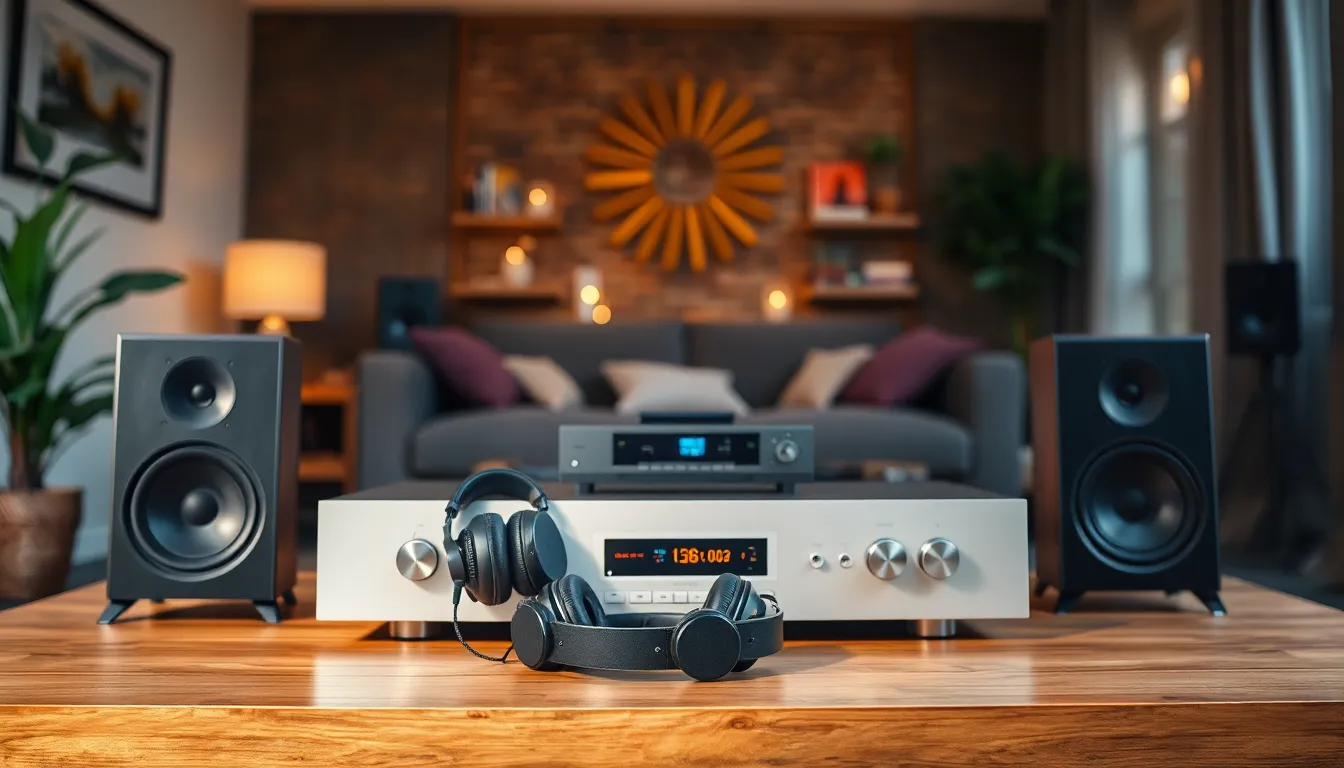Table of Contents
ToggleIn the ever-evolving world of music streaming, audio quality often takes center stage. As listeners seek immersive experiences, technologies like Dolby Atmos have gained popularity for their ability to create a three-dimensional sound environment. Many audiophiles and casual listeners alike are curious about whether Spotify, one of the leading streaming platforms, has integrated this cutting-edge audio technology into its offerings.
As Spotify continues to innovate and enhance its user experience, the question of Dolby Atmos support becomes increasingly relevant. This article dives into the current state of Dolby Atmos on Spotify, exploring what it means for users and how it compares to other platforms. Understanding this feature could change how they enjoy their favorite tunes, making it essential for music lovers to stay informed.
Overview Of Dolby Atmos
Dolby Atmos enhances audio by creating a three-dimensional sound environment. Unlike traditional surround sound, which channels audio to speakers, Dolby Atmos allows sounds to move freely, providing a more immersive experience. This technology uses metadata to define sound elements, making it possible for them to originate from any direction.
Dolby Atmos supports various formats, including movies, games, and music. In cinema, it offers a captivating experience, surrounding viewers with sound that corresponds with actions on the screen. In gaming, it heightens realism, allowing players to discern sounds from different spatial locations. In music, it provides artists with the ability to create dynamic soundscapes, enriching the listener’s journey.
Many major streaming platforms, such as Apple Music and Amazon Music, have adopted Dolby Atmos. Its growing availability acknowledges the shift towards high-fidelity audio experiences. Users with compatible devices can enjoy this technology, further emphasizing the value of high-quality sound in modern music consumption.
Spotify’s Audio Features

Spotify emphasizes audio quality with various features designed to enhance the listening experience. While many users seek high-fidelity sound, Spotify has not yet integrated Dolby Atmos into its offerings.
Current Surround Sound Options
Spotify currently supports stereo and surround sound configurations, primarily through its standard audio playback. Users enjoy a quality listening experience with popular formats such as AAC and Ogg Vorbis. Some playlists and tracks feature higher bitrates, providing clearer sound. Furthermore, Spotify Connect enables users to stream audio directly through compatible devices, optimizing playback quality depending on hardware capabilities.
Comparison with Other Streaming Services
Spotify’s audio features differ significantly from those offered by competitors like Apple Music and Amazon Music. Both Apple Music and Amazon Music provide Dolby Atmos, allowing listeners to experience three-dimensional audio. Apple Music has integrated spatial audio features, enhancing its library with immersive soundscapes. Amazon Music also offers Dolby Atmos tracks, targeting high-fidelity enthusiasts. As high-quality audio becomes increasingly important, Spotify’s absence of Dolby Atmos may affect its appeal to audiophiles seeking immersive experiences.
Does Spotify Have Dolby Atmos?
Spotify doesn’t currently support Dolby Atmos, making it distinct from other music streaming services that offer this audio technology. Users seeking immersive sound experiences might find this limitation significant.
Official Announcement and Updates
Spotify has yet to provide an official announcement regarding the integration of Dolby Atmos into its platform. While the company remains at the forefront of music streaming, the absence of updates on potential support for Dolby Atmos suggests it’s not currently a priority. Market trends indicate that consumers increasingly favor high-fidelity audio experiences, putting pressure on Spotify to consider expanding its audio capabilities.
Limitations and Availability
Spotify’s audio features, such as stereo and surround sound, cater to a variety of listening preferences, yet fall short of delivering Dolby Atmos quality. The lack of this technology restricts Spotify users from experiencing the enhanced spatial audio that competitors like Apple Music and Amazon Music offer. Additionally, the unavailability of Dolby Atmos may deter audiophiles who prioritize superior sound quality for their music collections.
User Experience With Dolby Atmos
Dolby Atmos enhances the listening experience by offering spatial audio that immerses users in sound. It represents a significant leap in audio quality, appealing especially to discerning music lovers.
Sound Quality Comparisons
Comparing sound quality across streaming platforms highlights the advantages of Dolby Atmos. Platforms like Apple Music and Amazon Music provide immersive audio experiences, utilizing Dolby Atmos to create rich, three-dimensional soundscapes. This technology allows for precise audio placement, enhancing clarity and depth that traditional formats cannot achieve. In contrast, Spotify’s current audio formats, including AAC and Ogg Vorbis, deliver solid sound quality, but they lack the dimensionality and natural feel offered by Dolby Atmos. Users seeking an elevated auditory experience may find the difference particularly noticeable when switching between these platforms, reinforcing their preference for Dolby Atmos-enabled services.
Listener Feedback
Listener feedback reflects a growing demand for higher audio quality in music streaming. Many users express enthusiasm for spatial audio experiences, emphasizing the enjoyment derived from immersive sound environments. Audiophiles and casual listeners alike report that Dolby Atmos elevates their music experiences, providing a sense of space and detail that stereo sound cannot replicate. While Spotify continues to provide a quality listening experience, feedback frequently points to the absence of Dolby Atmos as a drawback. This dissatisfaction may drive users to explore alternative platforms that prioritize immersive audio, showcasing the importance of Dolby Atmos in shaping consumer preferences in the music streaming industry.
Future of Dolby Atmos on Spotify
Spotify’s future regarding Dolby Atmos integration remains uncertain. As the demand for high-quality audio continues rising, Spotify could adapt its offerings to enhance user experience. Observing trends within the music streaming landscape, competitors like Apple Music and Amazon Music rapidly adopt Dolby Atmos, attracting audio enthusiasts seeking immersive sound experiences.
Spotify’s strength lies in its user base and accessibility; integrating Dolby Atmos might expand its appeal to audiophiles. Market analysis highlights an emerging preference for spatial audio across various demographics. If Spotify embraces this technology, it can position itself competitively in the streaming sector.
Current insights indicate that Spotify listens to user feedback, which increasingly emphasizes audio quality. Listener demands focus on immersive soundscapes and clarity, crucial elements of the Dolby Atmos experience. Should Spotify prioritize this technology, it might improve user satisfaction and retention.
Moreover, Spotify’s partnership potential with audio technology companies could facilitate Dolby Atmos integration. Collaborations may lead to new features and innovations that capture the attention of music lovers. The growing trend towards high-fidelity audio suggests Spotify must consider Dolby Atmos to stay relevant.
Finally, as user expectations evolve, Spotify’s strategy may include adopting advanced audio formats. Keeping pace with changes in consumer behavior will be critical for maintaining its user base. The future of Dolby Atmos on Spotify could shape the platform’s trajectory in the competitive streaming market.
The absence of Dolby Atmos on Spotify raises questions about its future in the competitive streaming landscape. As audiophiles increasingly seek immersive listening experiences, Spotify’s current offerings may not fully satisfy their demands. While the platform remains popular for its user-friendly interface and extensive library, the integration of advanced audio technologies like Dolby Atmos could enhance its appeal.
As the music industry shifts towards high-fidelity audio, Spotify’s ability to adapt will be crucial. Embracing spatial audio could not only improve user satisfaction but also help retain its audience. The evolving preferences of music lovers indicate that Spotify must consider integrating Dolby Atmos to remain competitive in a market where sound quality is becoming paramount.




